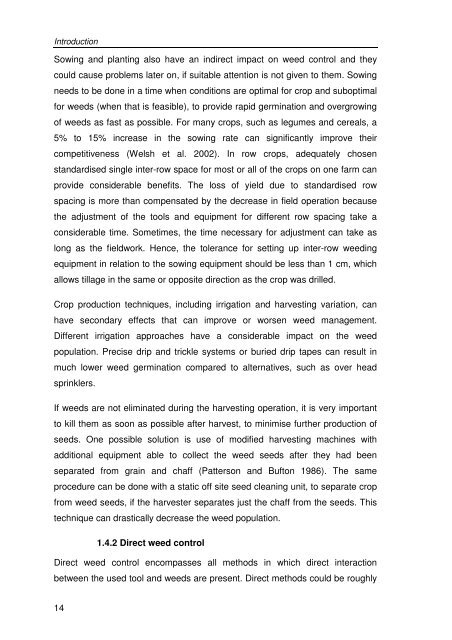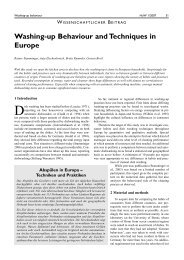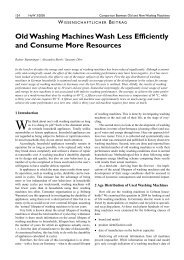Development of a novel mechatronic system for mechanical weed ...
Development of a novel mechatronic system for mechanical weed ...
Development of a novel mechatronic system for mechanical weed ...
Create successful ePaper yourself
Turn your PDF publications into a flip-book with our unique Google optimized e-Paper software.
Introduction<br />
Sowing and planting also have an indirect impact on <strong>weed</strong> control and they<br />
could cause problems later on, if suitable attention is not given to them. Sowing<br />
needs to be done in a time when conditions are optimal <strong>for</strong> crop and suboptimal<br />
<strong>for</strong> <strong>weed</strong>s (when that is feasible), to provide rapid germination and overgrowing<br />
<strong>of</strong> <strong>weed</strong>s as fast as possible. For many crops, such as legumes and cereals, a<br />
5% to 15% increase in the sowing rate can significantly improve their<br />
competitiveness (Welsh et al. 2002). In row crops, adequately chosen<br />
standardised single inter-row space <strong>for</strong> most or all <strong>of</strong> the crops on one farm can<br />
provide considerable benefits. The loss <strong>of</strong> yield due to standardised row<br />
spacing is more than compensated by the decrease in field operation because<br />
the adjustment <strong>of</strong> the tools and equipment <strong>for</strong> different row spacing take a<br />
considerable time. Sometimes, the time necessary <strong>for</strong> adjustment can take as<br />
long as the fieldwork. Hence, the tolerance <strong>for</strong> setting up inter-row <strong>weed</strong>ing<br />
equipment in relation to the sowing equipment should be less than 1 cm, which<br />
allows tillage in the same or opposite direction as the crop was drilled.<br />
Crop production techniques, including irrigation and harvesting variation, can<br />
have secondary effects that can improve or worsen <strong>weed</strong> management.<br />
Different irrigation approaches have a considerable impact on the <strong>weed</strong><br />
population. Precise drip and trickle <strong>system</strong>s or buried drip tapes can result in<br />
much lower <strong>weed</strong> germination compared to alternatives, such as over head<br />
sprinklers.<br />
If <strong>weed</strong>s are not eliminated during the harvesting operation, it is very important<br />
to kill them as soon as possible after harvest, to minimise further production <strong>of</strong><br />
seeds. One possible solution is use <strong>of</strong> modified harvesting machines with<br />
additional equipment able to collect the <strong>weed</strong> seeds after they had been<br />
separated from grain and chaff (Patterson and Bufton 1986). The same<br />
procedure can be done with a static <strong>of</strong>f site seed cleaning unit, to separate crop<br />
from <strong>weed</strong> seeds, if the harvester separates just the chaff from the seeds. This<br />
technique can drastically decrease the <strong>weed</strong> population.<br />
14<br />
1.4.2 Direct <strong>weed</strong> control<br />
Direct <strong>weed</strong> control encompasses all methods in which direct interaction<br />
between the used tool and <strong>weed</strong>s are present. Direct methods could be roughly





